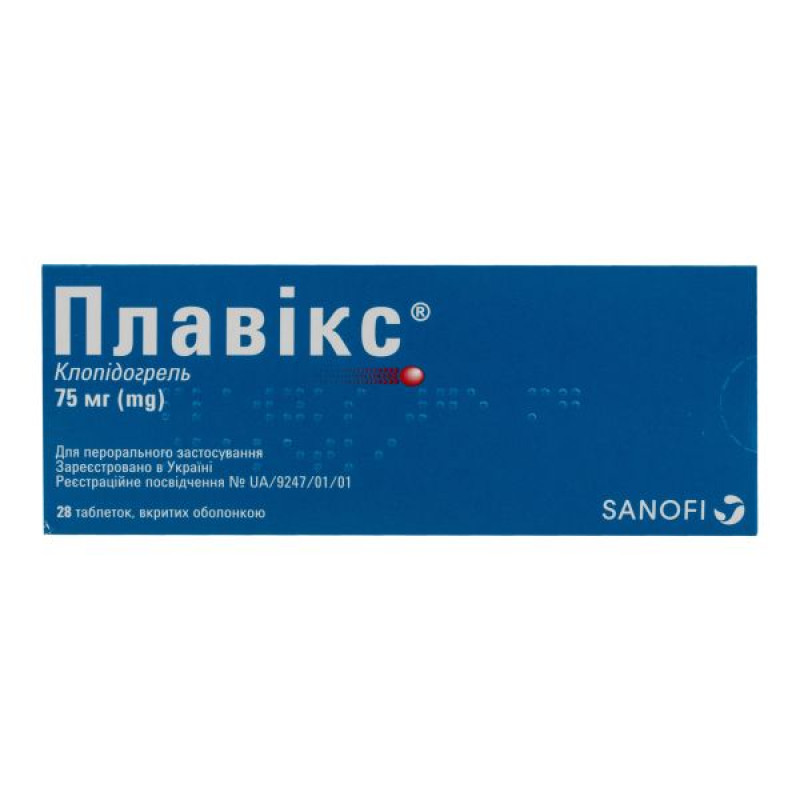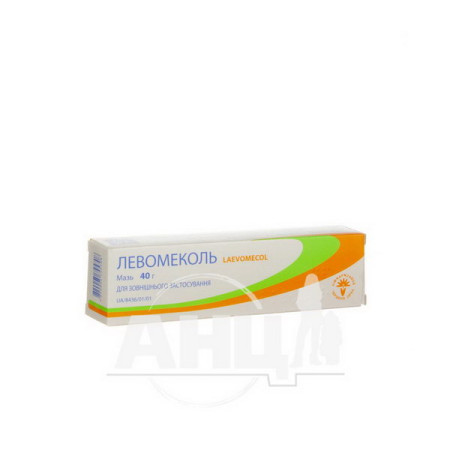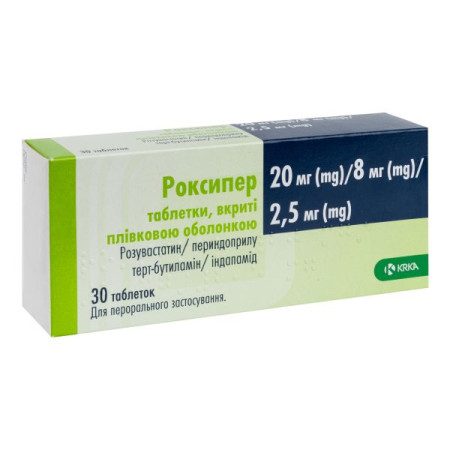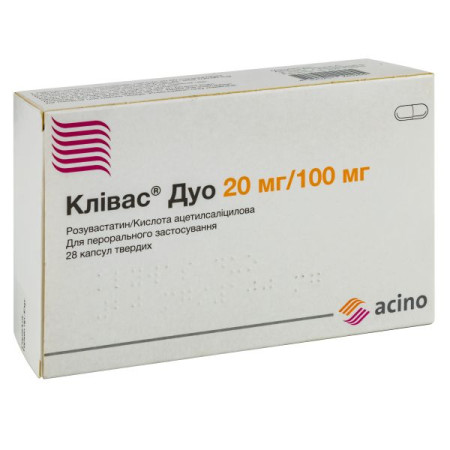Plavix film-coated tablets 75 mg No. 28
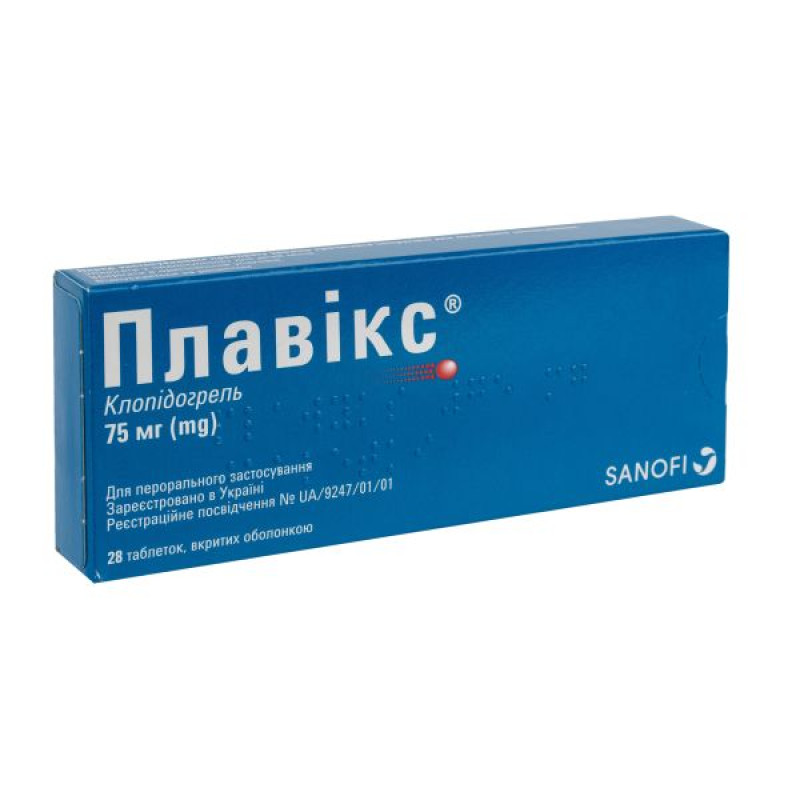
Instructions for Plavix film-coated tablets 75 mg No. 28
Composition
active ingredient: clopidogrel;
1 tablet contains clopidogrel hydrosulfate as base 75 mg;
excipients: mannitol (E 421), microcrystalline cellulose, polyethylene glycol, low-substituted hydroxypropylcellulose, hydrogenated castor oil, coating: Opadry 32K14834, type II (lactose monohydrate, hypromellose, titanium dioxide (E 171), triacetin, red iron oxide (E 172)), carnauba wax.
Dosage form
Film-coated tablets.
Main physicochemical properties: pink, round, slightly convex, film-coated tablets, engraved with "75" on one side and "1171" on the other.
Pharmacotherapeutic group
Platelet aggregation inhibitors, except heparin.
ATX code: B01A C04.
Pharmacological properties
Pharmacodynamics
Mechanism of action. Clopidogrel is a prodrug. One of the metabolites of clopidogrel is an inhibitor of platelet aggregation. To form the active metabolite, which inhibits platelet aggregation, clopidogrel must be biotransformed by cytochrome CYP 450 enzymes. The active metabolite of clopidogrel selectively inhibits the binding of adenosine diphosphate (ADP) to its P2Y12 receptors on the platelet surface and the subsequent ADP-induced activation of the glycoprotein IIb/IIIa complex, thereby inhibiting platelet aggregation. Since the binding is irreversible, platelets that have interacted with clopidogrel remain altered throughout their lifespan (which is approximately 7–10 days), and the restoration of normal platelet function occurs at a rate that corresponds to the rate of platelet turnover. Platelet aggregation induced by agonists other than ADP is also inhibited by the drug blocking platelet activation by released ADP.
Since the active metabolite is formed by cytochrome CYP 450 enzymes, some of which are polymorphic or inhibited by other drugs, not all patients experience sufficient inhibition of platelet aggregation.
Pharmacodynamic effects. From the first day of use, repeated daily doses of 75 mg of the drug show a significant slowdown in ADP-induced platelet aggregation. This effect progressively increases and stabilizes between 3 and 7 days. At steady state, the average level of inhibition of aggregation under the influence of a daily dose of 75 mg is from 40 to 60%. Platelet aggregation and bleeding time return to baseline levels on average 5 days after discontinuation of treatment.
Clinical efficacy and safety: The safety and efficacy of clopidogrel have been evaluated in 7 double-blind studies involving over 100,000 patients: the CAPRIE study, comparing clopidogrel with acetylsalicylic acid (ASA), and the CURE, CLARITY, COMMIT, CHANCE, POINT and ACTIVE-A studies, comparing clopidogrel with placebo, both in combination with ASA and other standard therapy.
Recent myocardial infarction (MI), stroke, or established peripheral arterial disease. The CAPRIE study enrolled 19,185 patients with atherothrombosis as defined by recent myocardial infarction (<35 days ago), recent ischemic stroke (7 days to 6 months ago), or established peripheral arterial disease (PAD). Patients were randomized to receive clopidogrel 75 mg/day or ASA 325 mg/day and were followed for 1 to 3 years. In the myocardial infarction subgroup, most patients received ASA within the first few days after the onset of myocardial infarction.
Clopidogrel significantly reduced the incidence of new ischemic events (a composite endpoint of myocardial infarction, ischemic stroke, and vascular death) compared with ASA. When analyzed according to the treatment assigned at the beginning of the study, 939 events were observed in the clopidogrel group and 1020 events in the ASA group (relative risk reduction (RR) - 8.7%, [95% CI: 0.2 - 16.4]; p = 0.045). That is, for every 1000 patients treated for 2 years, an additional 10 [CI: 0 - 20] patients avoided the development of a new ischemic event. Analysis of all-cause mortality as a secondary endpoint did not reveal significant differences between clopidogrel therapy (5.8%) and ASA (6%).
Subgroup analysis by relevant diseases (myocardial infarction, ischemic stroke and PAD) showed that the greatest effect (reaching statistical significance at p = 0.003) was observed in patients with PAD (especially in those who had suffered myocardial infarction) (OR = 23.7%; CI: 8.9 – 36.2), a smaller effect (not significantly different from the effect of ASA) was observed in patients with stroke (OR = 7.3%; CI: -5.7 – 18.7 [p = 0.258]). In patients enrolled based on recent myocardial infarction alone, the effect of clopidogrel was numerically smaller but not statistically different from that of ASA (HR = -4%; CI: -22.5 - 11.7 [p=0.639]). In addition, subgroup analyses of patients of different ages showed that the beneficial effect of clopidogrel was lower in patients aged 75 years and older than in patients <75 years.
Acute coronary syndrome. The CURE study enrolled 12,562 patients with non-ST-segment elevation acute coronary syndrome (unstable angina or non-Q-wave myocardial infarction) who had chest pain or symptoms of ischemia within the previous 24 hours. Patients had ECG changes suggestive of new ischemia or elevations in cardiac enzymes or troponin I or T to at least twice the upper limit of normal. Patients were randomized to receive clopidogrel (loading dose of 300 mg, then 75 mg/day, n=6259) or placebo (n=6303), both in combination with ASA (75-325 mg once daily) and other standard therapy. Treatment duration was up to 1 year. In the CURE study, 823 (6.6%) patients also received concomitant therapy with a GPIIb/IIIa receptor antagonist. More than 90% of patients received heparin. This concomitant therapy did not statistically significantly affect the relative incidence of bleeding with clopidogrel and placebo.
The number of patients who reached the primary endpoint [cardiovascular death (CVD), myocardial infarction (MI), or stroke] was 582 (9.3%) in the clopidogrel group and 719 (11.4%) in the placebo group. The relative risk reduction was 20% (95% CI 10%-28%; p=0.00009) for the clopidogrel group (17% for conservative management, 29% for patients who underwent percutaneous transluminal coronary angioplasty with or without stent placement, and 10% for patients who underwent coronary artery bypass grafting). Prevention of new cardiovascular events (primary endpoint) occurred with a relative risk reduction of 22% (CI: 8.6–33.4), 32% (CI: 12.8–46.4), 4% (CI: -26.9–26.7), 6% (CI: -33.5–34.3) and 14% (CI: -31.6–44.2) in the periods 0–1, 1–3, 3–6, 6–9 and 9–12 months of the study, respectively. That is, after more than 3 months of treatment, the beneficial effect observed in the clopidogrel + ASA group no longer increased, and the risk of bleeding remained (see section “Special instructions”).
The use of clopidogrel in the CURE study reduced the need for thrombolytic therapy (OR = 43.3%; CI: 24.3–57.5%) and GPIIb/IIIa glycoprotein receptor inhibitors (OR = 18.2%; CI: 6.5–28.3%).
The number of patients who reached the combined primary endpoint (CHD, MI, stroke, or refractory ischemia) was 1035 (16.5%) in the clopidogrel group and 1187 (18.8%) in the placebo group. The relative risk reduction was 14% (95% CI: 6–21%, p=0.0005) in the clopidogrel group. This effect was mainly due to a statistically significant reduction in the incidence of MI [287 (4.6%) in the clopidogrel group and 363 (5.8%) in the placebo group]. There was no change in the incidence of readmissions for unstable angina.
The results obtained in groups of patients with different characteristics (e.g. unstable angina or non-Q-wave MI, low- to high-risk status, diabetes, need for revascularization, age, gender) were consistent with the results of the primary analysis. In particular, an additional analysis of 2172 patients (17% of the total CURE patient group) who underwent stenting (Stent-CURE) showed that clopidogrel treatment, compared with placebo, resulted in a significant HR (26.2%), indicating a benefit of clopidogrel in preventing the primary endpoint (CHD, MI, stroke), as well as a significant HR (23.9%) for the second combined primary endpoint (CHD, MI, stroke, or refractory ischemia). Moreover, the safety profile of clopidogrel in this subgroup of patients did not raise any special concerns. Thus, the results of the additional analysis of the patient group coincide with the results of the entire study.
The beneficial effect of clopidogrel was demonstrated regardless of the receipt of immediate and long-term treatment with other cardiovascular agents (such as heparin/low molecular weight heparin, GPIIb/IIIa inhibitors, lipid-lowering agents, beta-blockers and ACE inhibitors). The efficacy of clopidogrel was independent of the dose of ASA (75-325 mg once daily).
In patients with acute ST-segment elevation MI, the safety and efficacy of clopidogrel were evaluated in two randomized, placebo-controlled, double-blind studies, CLARITY and COMMIT.
The primary endpoint was achieved by 15% of patients in the clopidogrel group and 21.7% in the placebo group. This resulted in an absolute reduction of 6.7% and a 36% advantage in favor of clopidogrel (95% CI: 24-47%; p < 0.001), mainly due to a reduction in the incidence of occlusion of an infarct-related artery. This advantage was observed in all pre-specified subgroups of patients stratified by age, sex, infarct location, and type of fibrinolytic or heparin therapy.
The two-factor design of the COMMIT trial included 45,852 patients who had symptoms suggestive of MI within the previous 24 hours, as confirmed by ECG abnormalities (e.g., ST-segment elevation or depression or left bundle branch block). Patients received clopidogrel (75 mg/day, n=22,961) or placebo (n=22,891) in combination with ASA (162 mg/day) for 28 days or until discharge from the hospital. The combined primary endpoints were death from any cause and first recurrent myocardial infarction, stroke, or death. The patient population consisted of 27.8% women, 58.4% ≥ 60 years (26% ≥ 70 years), and 54.5% receiving fibrinolytics.
Clopidogrel significantly reduced the relative risk of all-cause mortality by 7% (p = 0.029) and the relative risk of the combination of recurrent infarction, stroke, or death by 9% (p = 0.002), corresponding to an absolute reduction of 0.5% and 0.9%, respectively. This effect was observed in patients of all ages and sexes, regardless of fibrinolytic therapy, and was observed within the first 24 hours.
De-escalation of P2Y12 receptor inhibitors in acute coronary syndrome (ACS). Switching from a more potent P2Y12 receptor inhibitor to clopidogrel in combination with aspirin after the acute phase in patients with ACS was evaluated in two randomized, investigator-sponsored trials (ISS), the TOPIC and TROPICAL-ACS trials, with clinical outcome data.
The clinical benefit of the more potent P2Y12 inhibitors, ticagrelor and prasugrel, in pivotal trials was driven by a statistically significant reduction in the incidence of recurrent ischemic events (including acute and subacute stent thrombosis, myocardial infarction, and emergency revascularization). Although the benefit in terms of ischemic events was consistently confirmed during the first year, the reduction in recurrent ischemic events after ACS was greater during the first days after treatment. In contrast, post hoc analyses demonstrated a statistically significant increase in the risk of bleeding with the more potent P2Y12 inhibitors, occurring predominantly during the maintenance phase, after the first month after ACS. The TOPIC and TROPICAL-ACS trials were designed to investigate the possibility of reducing the incidence of hemorrhagic events while maintaining the efficacy of clopidogrel.
TOPIC (Term of Platelet Inhibition After Acute Coronary Syndrome) study. This randomized, open-label study enrolled patients with ACS who required percutaneous coronary intervention (PCI). Patients who were receiving aspirin and a more potent P2Y12 receptor blocker and who had no adverse events after one month were either switched to a fixed-dose combination of aspirin and clopidogrel (de-escalating dual antiplatelet therapy (DAPT)) or continued on their previous regimen (fixed DAPT).
A total of 645 of 646 patients with STEMI (ST-segment elevation myocardial infarction) or NSTEMI (non-ST-segment elevation myocardial infarction) or unstable angina (de-escalation DAPT (n = 322), unchanged DAPT (n = 323)) were analyzed. A 1-year follow-up visit was performed in 316 patients (98.1%) in the de-escalation DAPT group and in 318 patients (98.5%) in the unchanged DAPT group. The median follow-up for both groups was 359 days. The characteristics of the study cohort were similar in the 2 groups.
TROPICAL-ACS (Testing the Response to Platelet Inhibition in Long-Term Antiplatelet Therapy in Acute Coronary Syndromes) study. This randomized, open-label study enrolled 2610 patients with biomarker-positive ACS who had successfully undergone PCI. Patients were randomized to receive either prasugrel 5 or 10 mg/day (days 0–14) (n = 1309) or prasugrel 5 or 10 mg/day (days 0–7) followed by de-escalation to clopidogrel 75 mg/day (days 8–14) (n = 1309) in combination with ASA (< 100 mg/day). Platelet function tests (PFTs) were performed on day 14. Patients who used prasugrel alone continued to take prasugrel for 11.5 months.
Patients who were deescalated were assessed for high platelet reactivity (HPR). If HPR was ≥ 46 units, patients were switched back to prasugrel 5 or 10 mg/day for 11.5 months; if HPR was < 46 units, patients continued on clopidogrel 75 mg/day for 11.5 months. Thus, the managed escalation group included patients who received either prasugrel (40%) or clopidogrel (60%). All patients continued aspirin and were followed for one year.
The primary endpoint (combined endpoint of cardiovascular death, MI, stroke, and BARC grade ≥2 bleeding at 12 months) was met, demonstrating at least non-inferiority to clopidogrel. 95 patients (7%) in the managed de-escalation group and 118 patients (9%) in the control group (p for non-inferiority was 0.0004) experienced one of the endpoint events. Managed de-escalation did not increase the combined risk of ischemic events (2.5% in the de-escalation group compared with 3.2% in the control group; p for non-inferiority was 0.0115), nor did it increase the key secondary endpoint of BARC grade ≥2 bleeding events (5% in the de-escalation group compared with 6% in the control group (p = 0.23). The combined rate of all bleeding events (BARC grade 1–5) was 9% (114 events) in the managed de-escalation group compared with 11% (137 events) in the control group (p = 0.14).
Dual antiplatelet therapy for acute MI or TIA with intermediate and high risk
Dual antiplatelet therapy with a combination of clopidogrel and ASA for the prevention of stroke after acute MI or TIA at intermediate and high risk was evaluated in two randomized, investigator-sponsored trials (ISS)—CHANCE and POINT—for clinical safety and efficacy outcomes.
CHANCE (Clopidogrel Use in High-Risk Patients with Acute Non-Disabling Cerebrovascular Events)
This randomized, double-blind, multicenter, placebo-controlled clinical trial enrolled 5170 Chinese patients with acute TIA (ABCD2 score ≥ 4) or acute minor stroke (NIHSS score ≤ 3). Patients in both groups received open-label ASA on day 1 (75 to 300 mg at the discretion of the treating physician). Patients randomly assigned to the clopidogrel-ASA group received a loading dose of 300 mg clopidogrel on day 1, followed by 75 mg clopidogrel daily from days 2 to 90, and 75 mg ASA daily from days 2 to 21. Patients randomly assigned to the ASA group received a placebo version of clopidogrel from day 1 to day 90 of treatment and ASA at a dose of 75 mg per day from day 2 to day 90 of treatment.
The primary efficacy outcome was any new stroke event (ischaemic or haemorrhagic) within the first 90 days after an acute MI or high-risk TIA. These events occurred in 212 patients (8.2%) in the clopidogrel-ASA group compared with 303 patients (11.7%) in the ASA group (hazard ratio [HR] 0.68; 95% confidence interval [CI] 0.57 to 0.81; p < 0.001). MI occurred in 204 patients (7.9%) in the clopidogrel-ASA group compared with 295 patients (11.7%) in the ASA group (HR 0.67; 95% CI 0.56 to 0.81; p < 0.001). Hemorrhagic stroke occurred in 8 patients in each of the two study groups (0.3% in each group). Moderate or severe bleeding occurred in 7 patients (0.3%) in the clopidogrel-ASA group and in 8 (0.3%) in the ASA group (P = 0.73). The incidence of any bleeding event was 2.3% in the clopidogrel-ASA group compared with 1.6% in the ASA group (HR 1.41; 95% CI 0.95 to 2.10; P = 0.09).
POINT (Inhibition of platelet aggregation in new-onset TIA and minor ischemic stroke)
The primary efficacy endpoint was the composite of major ischemic events (MI, MI, or death due to ischemic vascular events) at day 90. These events occurred in 121 patients (5.0%) in the clopidogrel plus ASA group compared with 160 patients (6.5%) receiving ASA alone (HR 0.75; 95% CI 0.59 to 0.95; p < 0.02). The secondary efficacy endpoint was ischemic stroke. This occurred in 112 patients (4.6%) receiving clopidogrel plus ASA compared with 155 patients (6.3%) receiving ASA alone (HR 0.72; 95% CI 0.56 to 0.92; p = 0.01). The primary safety endpoint was major bleeding. It was observed in 23 of 2432 patients (0.9%) who received clopidogrel in combination with ASA and in 10 of 2449 patients (0.4%) who received ASA as monotherapy (HR 2.32; 95% CI 1.10 to 4.87; p = 0.02). Minor bleeding was observed in 40 patients (1.6%) who received clopidogrel in combination with ASA and in 13 patients (0.5%) who received ASA as monotherapy (HR 3.12; 95% CI 1.67 to 5.83; p = 0.001).
Analysis of the dynamics of the CHANCE and POINT studies
No efficacy benefit was found for extending dual antiplatelet therapy beyond 21 days. The dynamics of serious ischemic events and major hemorrhages in the treatment groups were examined to analyze the impact of a short-term course of DAPT.
Dynamics of serious ischemic events and massive hemorrhages in the treatment groups in the CHANCE and POINT studies
| Number of cases | ||||||||
| Research results CHANCE and POINT | Distribution by treatment group | Total | 1st week | 2nd week | 3rd week | |||
| Major ischemic events | ACS (n = 5,035) | 458 | 330 | 36 | 21 | |||
| Clopidogrel + ASA (n = 5,016) | 328 | 217 | 30 | 14 | ||||
| Difference | 130 | 113 | 6 | 7 | ||||
| Major bleeding | ACS (n = 5,035) | 18 | 4 | 2 | 1 | |||
| Clopidogrel + ASA (n = 5,016) | 30 | 10 | 4 | 2 | ||||
| Difference | -12 | -6 | -2 | -1 | ||||
Atrial fibrillation. ACTIVE-W and ACTIVE-A, which were separate studies within the ACTIVE program, enrolled patients with atrial fibrillation (AF) who had at least one risk factor for vascular events. Based on the study’s inclusion criteria, physicians enrolled patients in ACTIVE-W if they were candidates for vitamin K antagonist (VKA) therapy (e.g., warfarin). ACTIVE-A enrolled patients who were unable to receive VKA therapy due to contraindications or unwillingness to receive this treatment.
The ACTIVE-W study demonstrated that anticoagulant therapy with vitamin K antagonists was more effective than treatment with clopidogrel and ASA.
ACTIVE-A (n = 7554) was a multicenter, randomized, double-blind, placebo-controlled trial comparing clopidogrel 75 mg/day + ASA (n = 3772) with placebo + ASA (n = 3782). The recommended dose of ASA was 75 to 100 mg/day. Patients were treated for up to 5 years.
Patients randomized to ACTIVE had documented AF, i.e., persistent AF or at least 2 episodes of paroxysmal AF in the past 6 months, and at least one of the following risk factors: age ≥ 75 years or age 55 to 74 years or diabetes requiring medical treatment or documented prior MI or documented ischemic heart disease; prior treatment for systemic hypertension; prior stroke, transient ischemic attack (TIA), systemic embolism without CNS involvement; left ventricular dysfunction with left ventricular ejection fraction < 45% or documented peripheral vascular disease. The median CHADS2 score was 2 (range 0-6).
The main exclusion criteria for patients from the study included documented peptic ulcer disease within the last 6 months; history of intracerebral hemorrhage, severe thrombocytopenia (platelet count <50×109/L); need for clopidogrel or oral anticoagulants (OCs), or intolerance to either of these two agents.
73% of patients enrolled in the ACTIVE-A study were unable to receive VKA due to physician judgment, inability to monitor international normalized ratio (INR), susceptibility to falls or head injury, or specific bleeding risk factors; for 26% of patients, the physician's decision was based on the patient's unwillingness to receive VKA.
The number of patients who reached the primary endpoint (time to first occurrence of stroke, MI, systemic embolism without CNS involvement, or death) was 832 (22.1%) in the clopidogrel + ASA group and 924 (24.4%) in the placebo + ASA group (relative risk reduction of 11.1%, 95% CI: 2.4-19.1%; p = 0.013), primarily due to a significant reduction in the incidence of stroke. Strokes occurred in 296 (7.8%) patients treated with clopidogrel + ASA and 408 (10.8%) patients treated with placebo + ASA (relative risk reduction of 28.4%; 95% CI: 16.8-38.3%, p = 0.00001).
Children: In a dose-escalation study in 86 neonates or infants up to 24 months of age at risk of thrombosis (PICOLO), clopidogrel was administered at sequential doses of 0.01, 0.1, and 0.2 mg/kg to neonates and infants and at 0.15 mg/kg to neonates only. At 0.2 mg/kg, the mean inhibition of platelet aggregation was 49.3% (5 μM ADP-induced platelet aggregation), which was comparable to that in adults receiving Plavix 75 mg/day.
In a randomized, double-blind, parallel-group study (CLARINET), 906 children (neonates and infants) with cyanotic congenital heart disease undergoing palliative surgery for systemic-pulmonary arterial shunting were randomized to receive clopidogrel 0.2 mg/kg (n = 467) or placebo (n = 439) with concomitant background therapy until the second stage of surgery. The median time between palliative surgery for shunting and the first administration of study drug was 20 days. Approximately 88% of patients received concomitant ASA (1 to 23 mg/kg/day). There was no significant difference between the groups in the primary composite endpoint of death, shunt thrombosis, or cardiac surgery up to 120 days of life after the thrombotic event, with rates of 89 [19.1%] in the clopidogrel group and 90 [20.5%] in the placebo group (see Dosage and Administration). The most common adverse reaction in both the clopidogrel and placebo groups was bleeding, but there was no significant difference between the groups in terms of its incidence. During the long-term follow-up period for adverse events, 26 patients who still had a shunt at 1 year of age received clopidogrel until 18 months of age. The safety profile of the drug was unchanged during this follow-up period.
The CLARINET and PICOLO studies used reconstituted clopidogrel solution. In a relative bioavailability study in adults, reconstituted clopidogrel solution demonstrated a similar extent and slightly higher rate of absorption of the major circulating (inactive) metabolite compared to the licensed tablet formulation.
Pharmacokinetics
Absorption. Clopidogrel is rapidly absorbed after single and multiple oral doses of 75 mg/day. The mean peak plasma concentration of unchanged clopidogrel (approximately 2.2-2.5 ng/ml after a single 75 mg oral dose) was reached approximately 45 minutes after dosing. Absorption is at least 50% based on urinary excretion of clopidogrel metabolites.
Distribution: Clopidogrel and the major (inactive) circulating metabolite are reversibly bound to human plasma proteins in vitro (98% and 94%, respectively). This binding remains unsaturated in vitro over a wide concentration range.
Metabolism. Clopidogrel is extensively metabolized in the liver. In vitro and in vivo, there are two main pathways of its metabolism: one involving esterases, which leads to hydrolysis with the formation of an inactive carboxylic acid derivative (which accounts for 85% of all metabolites circulating in plasma), and the other involving enzymes of the cytochrome P450 system. Clopidogrel is first converted to the intermediate metabolite 2-oxo-clopidogrel. As a result of further metabolism of 2-oxo-clopidogrel, a thiol derivative is formed - the active metabolite. This active metabolite is formed mainly by the enzyme CYP2C19, with the participation of several other enzymes of the CYP system, such as CYP1A2, CYP2B6 and CYP3A4. The active metabolite of clopidogrel (a thiol derivative), which was isolated in vitro, binds rapidly and irreversibly to receptors on platelets, thereby inhibiting platelet aggregation.
The Cmax for the active metabolite is twice as high after a single 300 mg loading dose of clopidogrel compared to that observed after 4 days of 75 mg maintenance dose. Cmax is reached approximately 30–60 minutes after administration.
Elimination. After 120 hours of oral administration of 14C-labeled clopidogrel in humans, approximately 50% of the dose was excreted in the urine and approximately 46% in the feces. After a single oral dose of 75 mg, the elimination half-life of clopidogrel is approximately 6 hours. The elimination half-life of the main (inactive) metabolite circulating in the blood is 8 hours after single and multiple administration of the drug.
The CYP2C19*1 allele corresponds to a fully functional metabolism, while the CYP2C19*2 and CYP2C19*3 alleles correspond to a non-functional metabolism. The CYP2C19*2 and CYP2C19*3 alleles constitute the majority of alleles in Caucasian (85%) and Mongoloid (99%) patients with reduced metabolism. Other alleles associated with absent or impaired metabolism are much less common. These include CYP2C19*4, *5, *6, *7, and *8. A patient with reduced metabolism has two non-functional alleles, as noted above. According to published data, CYP2C19 genotypes corresponding to reduced metabolism are found in 2% of Caucasians, 4% of Negroids, and 14% of Chinese patients. There are now tests that can determine the CYP2C19 genotype.
In a crossover study involving 40 healthy volunteers, 10 in each of four groups corresponding to a specific CYP2C19 metabolizer type (ultra-rapid, extensive, intermediate, and poor), the pharmacokinetics and antiplatelet effects of a 300 mg dose followed by 75 mg daily and a 600 mg dose followed by 150 mg daily were evaluated. Each of these treatments was administered for a total of 5 days (until steady state was achieved). There were no significant differences in blood concentrations of the active metabolite and mean platelet aggregation inhibition (PAI) between ultra-rapid, extensive, and intermediate metabolizers. In poor metabolizers, blood concentrations of the active metabolite were reduced by 63-71% compared with extensive metabolizers. After the 300 mg/75 mg regimen, the antiplatelet effects in poor metabolizers were less pronounced, with mean PAO (5 μM ADP) of 24% (24 hours) and 37% (day 5) compared with PAO of 39% (24 hours) and 58% (day 5) in extensive metabolizers and 37% (24 hours) and 60% (day 5) in intermediate metabolizers. When poor metabolizers were given the 600 mg/150 mg regimen, the blood concentration of the active metabolite was higher than with the 300 mg/75 mg regimen. In addition, the PBMC values were 32% (24 hours) and 61% (day 5), which were higher than those in poor metabolizers receiving the 300 mg/75 mg dose and similar to those obtained in other CYP2C19 metabolizer groups using the 300 mg/75 mg dose regimen. The appropriate dose regimen for this patient population has not been determined from clinical efficacy studies.
Similar to the results above, a meta-analysis of 6 studies using steady-state data from 335 patients treated with clopidogrel demonstrated that the concentration of the active metabolite in the blood was reduced by 28% in intermediate metabolisers and 72% in poor metabolisers; inhibition of platelet aggregation (5 μM ADP) was also reduced, with a difference in PTH of 5.9% and 21.4%, respectively, compared with extensive metabolisers.
The effect of CYP2C19 genotype on clinical outcomes in patients treated with clopidogrel has not been studied in prospective randomized controlled trials. However, a number of retrospective analyses have been conducted to assess this effect in patients treated with clopidogrel for whom genotyping results are available: CURE (n = 2721), CHARISMA (n = 2428), CLARITY-TIM 28 (n = 227), TRITON-TIM 38 (n = 1477), and ACTIVE-A (n = 601). In addition, there are results from several published cohort studies.
In an analysis of TRITON-TIMI 38 and 3 cohort studies (Collet, Sibbing, Giusti), the combined group of intermediate and poor metabolizers had a higher incidence of cardiovascular events (fatal outcome, myocardial infarction, and stroke) or stent thrombosis than extensive metabolizers.
In the CHARISMA analysis and one cohort study (Simon), poor metabolizers had an increased event rate compared with extensive metabolizers.
In the analyses of CURE, CLARITY, ACTIVE-A and one of the cohort studies (Trenk), the incidence of cardiovascular events was not significantly dependent on metabolic characteristics.
None of these analyses included a sufficient number of patients to detect differences.
There are no reviews for this product.
There are no reviews for this product, be the first to leave your review.
No questions about this product, be the first and ask your question.




